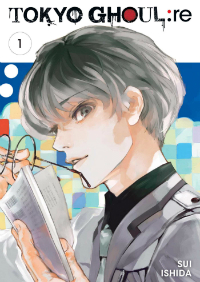
Author: Sui Ishida
Release Date: Oct. 16, 2014 (Japan); Oct. 17, 2017 (U.S.)
Publisher: Viz Media
Source: MediaLab
Genre(s): Action, Mystery, Drama, Horror, Supernatural, Psychological, Seinen
Goodreads | Amazon | MyAnimeList
Sui Ishida’s Tokyo Ghoul: re Volume 1 is the first volume of the sequel to his original, Tokyo Ghoul. The latter was released in September of 2011 and concluded in September of 2014. Shortly after, re hit Japanese shelves and made an English debut in the U.S. about three years later.
It became the 10th best-selling manga series of 2015 in Japan. The original revolved around a timid high schooler, Ken Kaneki, thrust into the underground ghoul society by a fatal chance encounter. The story centered on his declining human condition and evolution into an immensely powerful ghoul. We experienced the world primarily through the eyes of peaceful ghouls hunted by the government.
Ishida’s sequel tells the story of a new department of the government’s ghoul extermination organization. With the new plot, comes new characters and new developments to the world around them. One such development is the new ability for government soldiers to use ghoul weapons through surgical alterations.
Key Takeaways
- There is interesting chemistry between some characters and contrasting tension between others.
- A new plot development that radically transforms the battlefield occupied by ghouls and their human opponents.
- It’s a good read for both fans and newcomers.
How We’ll Judge
How should you judge a sequel? The first instinct is to base the value solely on a comparison to the original. Makes sense right? Except it doesn’t.
Some sequels attain what all sequels dream of, standalone value. When a sequel possesses such value, you can skip the original and still appreciate the sequel greatly. Tokyo Ghoul: re has said value and, henceforth, will be treated as such. Therefore, no comparisons to Kaneki’s, sickeningly pathetic, self-pity; team Anteiku ditching the coffee beans to go full ghoul on the government or Shuu Tsukiyama’s bizarre obsession with eating Kaneki.
However, while we must critically evaluate it to some extent as an individual piece of work, it still maintains a connection to the original. So, we will judge it on its ability to be enjoyed by both fan and newcomer alike.
Story
This plot has layers. This isn’t just another tale of humans fighting monsters. This is a team of humans making a deal with the devil to be the best at killing said devils in sheep’s clothing. How far will the humans go to defeat the monsters? You’ll see just how far and the answer says more about the humans than the beasts they hunt. While the events of the story lose some weight if you’ve missed the original series, it’s still a pretty great kickoff to what’s to come.
The world fits the plot and characters perfectly. Trust me bruh, fits like a glove. The world adds context to the characters’ actions and deems them, not only reasonable but also necessary. The world, like the story, has multiple layers.
In volume 1, we’re introduced to the bureaucratic world of the commission of counter ghoul, which is akin to a bucket of crabs clambering for the rim. Being a competent investigator is almost as important as surviving. We also see the outside world, in which danger hides behind unassuming faces around every corner. Only in such a world could these grisly events occur. There is a history and a fall-out from past events that have built the world into what it is.
The characters are exactly who the world needs, like Batman to Gotham. They stand apart from one another. Their level of commitment to ridding the world of ghouls and even their moral opinions of the creatures vary wildly between each other. Still, they’ll sacrifice their humanity if it brings the end of all ghouls.
Visual Appeal
The panel layout is anything but basic. It’s an excellent mix of organizational variety. Each page maximizes the space provided to showcase as much detail as needed. Most of the pages carry ridiculous amounts of information and plot material without looking cluttered.
Through layout, the scenes based more on information carry a slower pace than the others, while still playing with panel size and shape. When the action comes, boy does it come. Ishida ditches the comprehensive, tight fit for spacious, compelling action.
The art style is more of the same, which shouldn’t be disappointing in any sense. For fans, it’s comfortably familiar and for newcomers, it complements the story well.
The character design lacks significant originality, but many of the characters attain distinction through their actions and personality quirks.
Final Thoughts
I’m glad I started the Tokyo Ghoul continuity with the initial story. In my case, it just allowed for a deeper understanding of how the world has changed and a stronger connection to the plot. That being said, it’s a great read regardless and your lack of exposure to the predecessor shouldn’t steer you away from this popular entry.
Similar to:
- Tokyo Ghoul: Style, Plot, and Themes
- Kiseijuu: Themes
- Claymore: Style and Plot
- Terra Formars: In Style, Plot, and Themes
